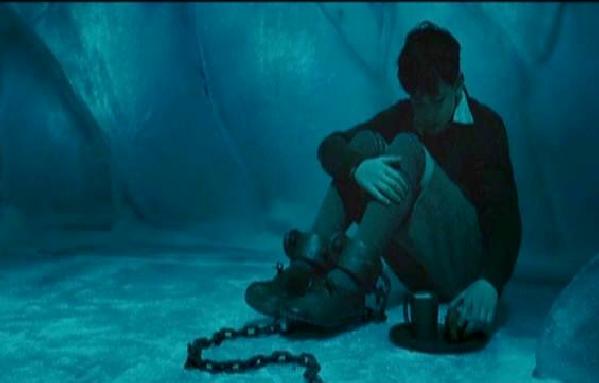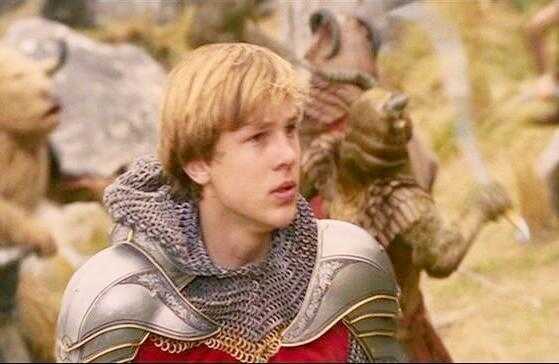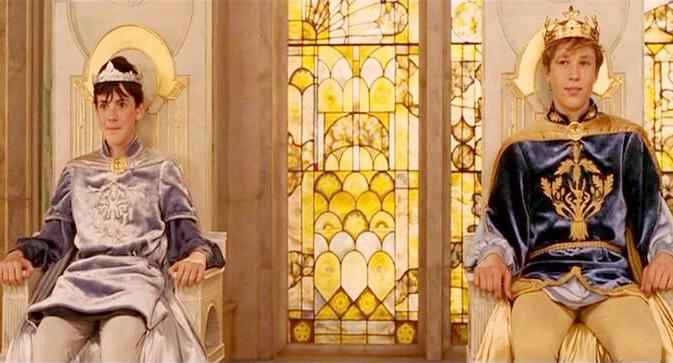
The Chronicles of Narnia: The Lion, the Witch and the Wardrobe (United States, 2005)

Figure 1.--The children's clothes are very true to what school children wore in Great Britain during the War. Peter wears long trousers with braces (suspenders) while Edmund wears short trousers, knee socks and a sweater. When Edmund is shackled as a prisoner in his freezing cell, he pulls the tops of his knee socks up over his knees like long stockings to try to keep warm.
|
|
This is the first major production of the classic C.S. Lewis novel, "The Chronicles of Narnia: The Lion, the Witch and the Wardrobe". The film was directed by Andrew Adamson and was released in
2005. The story concerns four siblings (children of Penvensie family) who are sent away to the country to live with an eccentric professor during the World War II Blitz of London. The children are
Lucy, age 9 (played by Georgie Henley), Edmund, age 11 (played by Skandar Keynes), Susan, age 12 (played by Anne Popplewell), and Peter, age 14 (played by William Moseley). All the children are beautifully
played. This was a very popular children's book in Britain, but less familiar to American children. There have been TV productions of the book, but with rather ameturish special effects. This film has the sophisticated special affects needed to bring the Lewis story to life.
Filmology
This is the first major production of the classic C.S. Lewis novel, "The Chronicles of Narnia: The Lion, the Witch and the Wardrobe". The film was directed by Andrew Adamson and was released in
2005. There have been TV productions of the book, but with rather ameturish special effects. This film has the sophisticated special affects needed to bring the Lewis story to life.
C.S. Lewis (1898-1963)
C.S. Lewis was a respected university professor, not the kind of person that one would think would write a children's classic. Lewis was a Medieval scholar a Oxford, he wrote children's books for his own amusement, but the Narnia Chronicles became classics of children's literature. His mother was a brilliant mathematician and his father was a solicitor. He lived in a large, drafty house with untold little hideaways. He began writing at about 5 and created his own imaginary world with his younger brother. He continued to write his fantasies until he was packed away to strict, formal boarding school at 12. He was fitted with a stiff Eton collar and suffered from the strict discipline. He writes in detail about the school in his lovely little book Surprised by Joy. He lived the life of a bachelor scholar until late in his life he met an American poet and author, a married woman with two children--the Joy in his book. He was captivated by her and the boys, but had difficulty with adjusting his bachelor habits and the ethics of the relationship as she was still, if unhappily, married. She contracts cancer which devastates him, but marries her before she dies. The story of his later years is nicely depicted in a British docudrama 'Shadowlands'. An American studentvat Oxford writes, "As students we were hardly aware of Lewis's children's books, alhough we read his scholarly works on English literature of course. Lewis was a brilliant lecturer on Renaissance English literature. But his non-scholarly work (children's literature and Christian apologetics) was very much a sideline. Lewis's colleagues at Oxford didn't much approve of the writings that eventually made him famous, and he kept a fairly low profile about such matters when lecturing at the university. I met him because my tutor at Merton College was Lewis's best friend, which is how we got introduced. Lewis was a don at Magdalene College, which was very near my college (and in many respects a rival to it). I did occasionally see Lewis at church. He and my tutor sometimes went to Mass together and I would sometimes sit near them. He could be a bit crusty toward undergraduates--especially foreign undergraduates like myself. He and my tutor belonged to a group of writers and intellectuals who called
themselves "The Inklings". Tolkein, whose lectures on medieval literature I also attended as an undergraduate, was also a member of the group. The group also included Dorothy Sayers, the writer of
mystery stories and the translator of Dante. We didn't know that Tolkein was working on his famous trilogy, The Lord of the Rings, which later became so famous. The Inklings were all in love with things medieval and were devoutly religious--mostly Anglo-Catholics and Roman Catholics." A play about the relationship Lewis and American poet Joy Davidman was released as Shadowlands.
The Blitz (September-October 1940)
Off-course German bombers accidentally bombed London on August 23-24, 1940. RAF Bomber Command on August 25-26 directed a small reprisal raid against Berlin. Hitler growing inpatient with the air battle and troubled by the losses of planes and crews was furious. A string believer in terror tactics, he was outraged that such attacks should be used against Germany. He called the British "night gangsters" and ordered an immediate change in Luftwaffe tactics. Rather than completing its offensive against the RAF infrastructure, Hitler ordered a "Blitz" on British cities which began in earnest on September 7. British children had been evacuated from London and the other major cities when World War II broke out (September 1939). But when the Germans did not begin bombing at once, many of the parents gradually brought their children home. This changed when the beginning of the Nattle of Britain (July 1940), especially the Blitz on London (September 1940) and the children were reevacuated.

Figure 2.-- After the children become involved in the battle for Narnia they wear medieval dress--the boys in armor and the girls in long gowns based on 15th century styles.
|
|
The Chronicles of Narnia was a very popular children's book in Britain, but less familiar to American children. The inspiration for the books came during the dark days of World War II as Britain fought alone aginst the NAZIs. Children from London and other major cities were evacuated to the countryside. C.S. Lewis took in four of the evacuees in his home--the Kilns. He had very little experiebce with children. He was rather rather surprised with how little imaginative tales the children had read. He decided to create one for them. He jotted down some notes about four children who he named Ann, Martin, Rose and Peter who like his charges had been evacuated to the countryside to be safe from the NAZI bombing. He used this as a basis for stories he told the children. He did not actially write the Narnia books until after the War. The first book, The Lion, the Witch and the Wardrobe was published in 1950. It had illustrations by Pauline Baynes. Lewis' Narnia was a land of mystery and wonder. It seems to symbolize a Europe conquered by the NAZIs. British children were enchanted.
Cast
The children are Lucy, age 9 (played by Georgie Henley), Edmund, age 11 (played by Skandar Keynes), Susan, age 12 (played by Anne Popplewell), and Peter, age 14 (played by William Moseley). All the children play their parts beautifully.
The Plot
The story concerns four siblings (children of Penvensie family) who are sent away to the country to live with an eccentric professor during the World War II Blitz of London. While playing hide and seek in a spooky country house owned by the professor, Lucy hides in a wardrobe and discovers through it a
passage the magigal world of Narnia, populated by fawns, gryphens, talking animals, and other fabulous creatures and ruled over by the wicked White Witch, who has turned the entire kingdom in a wintry
country of cruelty and oppression. The children have various adventures in this mystical world. Emund is imprisoned by the witch, for instance. The climax of the film is a huge battle for Narnia in
which the oppressed creatures revolt againt the witch (Tilda Swinton). Peter and Edumund command the army of righteousness and with the help of the friendly lion Aslan (among other things a symbol of Christ) free the land of Narnia from its oppressor. We see Peter and Edmund figthing in medieval armor and ultimately crowned when the victory is
won.

Figure 3.-- At the end when the children are all
given crowns of victory and treated as royalty, they are dressed like medieval princes and princesses. The two boys wear short tunics and tights.
|
|
Costuming
The children's clothes are very true to what school children wore in Great Britain during the War. Peter wears long trousers with braces (suspenders) while Edmund wears short trousers, knee socks and a
sweater. When Edmund is shackled as a prisoner in his freezing cell, he pulls the tops of his knee socks up over his knees like long stockings to try to keep warm. Lucy wears long stockings as a school
girl. After the children become involved in the battle for Narnia they wear medieval dress--the boys in armor and the girls in long gowns based on 15th century styles. At the end when the children are all
given crowns of victory and treated as royalty, they are dressed like medieval princes and princesses. The two boys wear short tunics and tights.
The BBC production of "The Chronicles of Narnia" had excellent acting and was quite faithful to the C.S. Lewis story. It shows off just how bad the BBC's special-effects department was before "Red Dwarf" gave them an opportunity to sharpen their skills on a regular basis! They were on more familiar ground with the costuming, however; interstingly, Peter (the oldest boy) wears shorts throughout although Pauline Baynes' illustrations (which date to the books' publication in the early-mid '50s) show him in long pants. One reader writes, "Personally, I'd rather seen him in the actor's 1990 street clothes talking to an Aslan that didn't look like a giant stuffed animal!" As in the books, Aslan, the wise lion, could be relied on to discern the truth of a situation. The children under his tutelage learned courage and a bedrock sense of right and wrong, gradually learning to acknowledge that troublesome state of in-between as well. The particular episode is called ‘Prince Caspian. I have included the preamble from the dvd cover for you. The image here comes from the "Prince Caspian" volume. This followed the first volume, "The Lion, the Witch and the Wardrobe" ends with peace returned to Narnia. In "Prince Caspian" the troubles have returned to Narnia. The evil King Miraz and his manipulative Queen Prunaprismia have proven a disaster for Narmia. Peace has yielded to destruction and suffering. Young Prince Caspian (Jean Marc Perret) is tge rightful heir and pledges to save the distressed kingdom. Prince Caspian sounds the magic horn to summon aid. While at a rural railway station Peter, (Richard Dempsey) Susan, (Sophie Cook) Edmund (Jonathon R Scott) and Lucy (Sophie Walker) are waiting for the train for the new school term. (As late s the 1950s many children attending private schools still went to school by train.) Then they sence Prince Caspian's call for help. The children are magically transported to a deep forrest in Narnia. Caspian and the children pull together a stealth army consisting of a wild mix of fauns, dwarves and various talking beasts. This is the group that will liberate Narnia.
HBC

Navigate thevHistorical Boys Clothing Site
[Return to the Main alphaberical Cf-Ch movie page]
[Return to the Main Christmas movie page]
[Return to the Main U.S. movie page]
[Introduction]
[Activities]
[Biographies]
[Chronology]
[Clothing styles]
[Countries]
[Girls]
[Theatricals]
[Bibliographies]
[Contributions]
[Essays]
[FAQs]
[Glossaries]
[Images]
[Links]
[Registration]
[Tools]
[Boys' Clothing Home]
Created: 7:13 PM 7/22/2006
Last updated: 7:13 PM 7/22/2006





